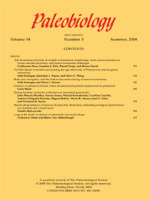The traditional “taxon counting” method of estimating ancient biodiversity is open to many criticisms, not least of which are the problem of inconsistency in the preservation of fossil organisms and the associated error on first and last appearance times of taxa. Construction of phylogenetic trees provides a way of correcting the first appearance of a taxon based on the origination time of its sister group. Workers have suggested that biodiversity studies include such phylogenetically implied range extensions. Potential problems with this method, in particular the bias inherent in altering origination—but not extinction—times, and the potential for incorrect addition of ghost ranges if the ancestor of a taxon is defined as its sister, are investigated by using a new computer simulation. The program creates a phylogeny, samples it and then adds ghost lineages, with diversity counts being made at all three stages. Results show that under certain conditions, such as in the case of a taxonomic group with many extant representatives, the phylogenetic method is superior to the taxic at capturing diversity pattern. However, there are also important conditions where the taxic approach provides an equal or superior estimate of diversity, such as if the group is extinct or has few extant lineages. Use of the phylogenetic method has the effect of magnifying the Signor-Lipps sampling effect seen before mass extinction events, and if ancestral species within a phylogeny are misdiagnosed as the sister species of their descendants, the phylogenetic method also consistently overestimates diversity magnitudes.
How to translate text using browser tools
1 January 2005
Estimating paleodiversities: a test of the taxic and phylogenetic methods
Abigail Lane,
Christine M. Janis,
J. John Sepkoski Jr.
ACCESS THE FULL ARTICLE

Paleobiology
Vol. 31 • No. 1
January 2005
Vol. 31 • No. 1
January 2005




